In a small hostel room in Bhubaneswar, two college students — Snehadeep Kumar from Durgapur and Mohit Kumar Nayak from Odisha — are quietly building something extraordinary: India’s first gamma-ray detecting CubeSat, a satellite that could one day rival NASA-level space tech.
Their mission? To prove that space innovation doesn’t need billion-dollar budgets — just big dreams, local metal, and unstoppable passion.
From Classroom Dreams to Space Reality
Snehadeep’s fascination with space began when his father gifted him an encyclopedia in Class 1. “I was hooked,” he recalls. “Every science project I did after that revolved around space.”
Years later, his dream took shape as the Nebula Space Organisation (NSO) — a student-led startup founded in 2021 to make space research affordable and accessible. When he met Mohit Kumar Nayak, a computer science student who shared the same obsession, the duo decided to build something monumental: a CubeSat capable of detecting gamma radiation, one of the most powerful and mysterious forces in the universe.
Space Innovation with Desi Ingenuity
Unlike big space agencies that spend millions, the NSO team sourced materials from local shops.
“The same aluminium that costs $180,000 through a space vendor was available for just Rs700 at a metal shop in Bhubaneswar,” says Snehadeep.
With CNC machining and local fabrication, they created precise, modular satellite parts — proving that India’s homegrown innovation can truly take off.
Their plug-and-play CubeSat will not only collect real-time data on gamma radiation but can also transmit live images from orbit via a mobile app. The design is cost-efficient, scalable, and entirely student-built.
Tackling Space Debris — Before It’s Too Late
While most satellites end up as space junk, Nebula’s CubeSats come with a built-in solution — solar sails that use sunlight to slowly push the satellite back into Earth’s atmosphere after its mission ends.
“We don’t want to add more waste to space,” explains Mohit. “Our design allows satellites to deorbit safely — no junk, no pollution.”
This sustainable approach makes Nebula Space one of the few student-led organisations worldwide addressing space debris with such precision and responsibility.
Recognition Beyond the Stratosphere
Their paper was recently accepted at the International Astronautical Congress 2024 in Milan, one of the most prestigious global space events — a dream milestone for any young researcher.
Despite limited funds, their work has caught the attention of venture capitalists and international mentors. The duo is now in talks to secure seed funding to take their CubeSat from blueprint to orbit.

The Future of Indian Space — Built by Students
India’s space economy is expected to soar from $8.4 billion in 2024 to $13 billion in 2025, and Nebula Space Organisation represents this new wave of young innovators.
“We want to make space data free for every student in the world,” says Mohit. “All they’ll need is their college ID.”
If successful, Nebula’s CubeSat will not only make history as India’s first student-built gamma-ray satellite but also redefine what young minds can achieve with vision and willpower.
In their words, “You don’t need a billion-dollar lab to dream big — just a pen, paper, and purpose.”
A New Era of Space, Made in India
Two students from Odisha are proving that the sky is not the limit — it’s just the beginning.


